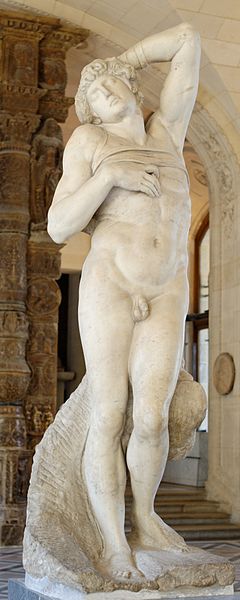The dying slave of Michelangelo Buonarotti
Be slave to Michelangelo
Michelangelo and his slaves: young slaves, bearded slaves, bound slaves and dying slaves. Famous is his sculpture „Dying Slave“, which was originally intended to adorn the monumental tomb of Pope Julius II. This dying slave, who was born in the years 1513 to 1516, was, like the rebellious slave, also known as bound slave, withdrawn from the project by the artist himself after many changes to the tomb meal and replaced by two other figures.
And:
In a sense, he, Michelangelo, became a slave himself, a slave to his own artistic life and to his patrons. Michelangelo said of himself that in him burned the Prometheus fire of his time, the time of the High Renaissance. He felt consumed, as when he glows inwardly, and he felt cramped when he was in a permanent dependency on popes and princes as his clients. „Man should not laugh when the whole world is in tears,“ he wrote later.
The saying vaguely touches on how Michelangelo felt in a time of bondage. He, the giant in the power of thought, passion and character described by Friedrich Engels. However, it can be said that perhaps it was precisely this perceived confinement that led to the highest content and sensuous expressiveness of his works. The motif of the captive, bound, constantly struggling for his freedom people impressed the artist sustainable and this is reflected in his artwork again. Even the dying slave touches this subject, or was created in this way by the artist.
Controversial
however, is the first impression of the dying slave. Rather devoted, the noble youth tends his perfectly built body into the hereafter. Does that look like dying? It should of course be considered that it was a first idea, for which this figure was originally designed and this dying man should not be a battlemen of battles, but rather a more a poetic figure.
Another perspective:
It is interesting that the same dying slave, seen here on the side of Stephan Bauer, looks in a different perspective (rotated by about 60 °) much more mortal. So it depends, as so often, on the viewing angle. A great figurative mastery certainly meets the viewer in the figure of the dying slave of Michelangelo. The nakedness of the man also shows his great vulnerability. What seems like a shirt at first is a bandage or a bandage or bandage that runs across the chest. The right leg pressed through is as contrary to the dying impression as the detached facial expression. All these components do not really fit in with dying. But what is already fitting and who may judge this fitting or inappropriate finally? Here one of the greatest artists shows us what art is and can be. Where more fitting than in the Louvre is this art treasure to admire. The figure ultimately remained unfinished.

